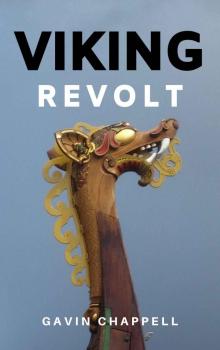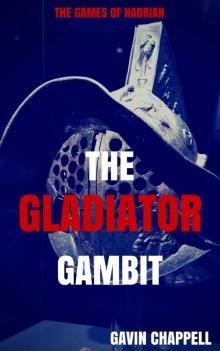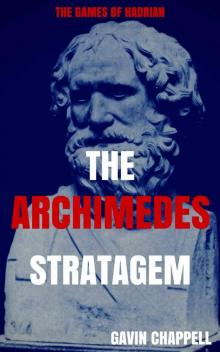- Home
- Gavin Chappell
The Guests of Odin Page 6
The Guests of Odin Read online
Page 6
In the meantime, Vadilgaut had died, and Vigleik, his son, had become king of the Angles. He had immediately begun to harass Gerutha, Amlodi’s mother, and stripped her of her royal wealth, saying that Amlodi had usurped the kingdom of the Jutes, and defrauded the King of the Angles, his overlord.
In a spirit of conciliation, Amlodi presented Vigleik with the richest of his spoils, but soon after he seized the chance for revenge, by attacking and subduing him. After this, Vigleik recruited the forces of the Angles, and challenged the Jutes to war. Amlodi saw that he was caught between disgrace and danger: if he accepted the challenge he would risk defeat or death, but to flee would be dishonourable. Finally, he decided to meet Vigleik on the field of combat.
But because he loved Jormunthrud so much, he was more concerned about her widowhood than his death. She said that she had a man’s courage, and would not abandon him on the battlefield. But she did not keep this promise. Amlodi rode against Vigleik in Jutland, and met his end in the fray. Now Jormunthrud accepted Vigleik’s offer of marriage, thus betraying Amlodi’s memory. So fell the Jutish royal house.
Bane of Champions
There was a king named Budli who ruled Sweden. He had a daughter named Hild. One day two men came before him, whose names were Alius and Olius, and both bragged of their skill as smiths. When he heard this, King Budli demanded that they prove their boasts. “Forge two swords for me, both of incomparable sharpness, which will cut through iron as well as they cut through wood or linen.”
Both smiths did as they were asked, and while Alius’ sword survived every test the king imposed upon it, King Budli found that Olius’ sword broke in the testing and he told the smith to forge another.
Unwillingly, Olius did as he was told but when he gave the king the new sword he said, “It will be the bane of Princess Hild’s two sons.”
Angered by this, the king struck at the smiths with the sword, but both vanished into thin air. Wanting to defy the prophecy, King Budli had his men take the sword, put it in a piece of hollow wood weighted with lead, and throw it into Lake Malaren near Agnafit.
Hildibrand the King of Hunland had a valiant son named Helgi, who came to King Budli’s court to sue for the hand in marriage of Princess Hild. King Budli approved of the man, and when he grew old found Helgi a great help in defending the borders of the realm. The Hun and his Swedish princess had a son who they named Hildibrand after his grandfather, with whom he was fostered when he grew older. In Hunland, young Hildibrand showed great promise.
Helgi was slain defending King Budli’s realm, and the Danish king Alf entered Sweden and slew King Budli in battle. King Alf’s greatest warrior was a man named Aki, and he gave him Princess Hild as a reward for his valour. Aki fathered a son on Hild, and they named the boy Asmund. Even while still a youth, Asmund made a name for himself as a Viking.
By then his half-brother Hildibrand had travelled widely and earned a name for himself by his courageous deeds: Champion of the Huns. Word came to him at last of his father’s death and he made his way to the Danes to gain revenge on King Alf. Aki and Asmund were off raiding in foreign lands. No one could withstand Hildibrand’s attack; the Hun Champion charged through Alf’s ranks in a berserk fit, and King Alf himself was slain, leaving only his daughter, Asa the Fair. By the time Aki and Asmund returned from their raids Hildibrand had gone and all was quiet again in the kingdom.
Asmund courted Asa but found a contender in another suitor, Eyvind Skinnhall. Faced by the two rivals for her affections, Asa gave them a capricious-seeming challenge; “Next autumn,” she said, “I will marry whichever one of you has the fairest hands.”
Accordingly, Eyvind spent the summer at his leisure, wearing gloves and sparing his hands any work. Asmund, however, returned to the life of a Viking, and gained much booty and honour although his hands were scarred and disfigured in numerous battles.
That autumn both suitors came to Asa’s hall to show the queen their hands for her judgement. Eyvind removed his gloves, showing his hands to be white and beautiful. Asmund’s hands on the contrary were cut and scarred, but upon his arms as far as his shoulders, he wore golden rings, booty he had taken in his plunderings. Asa declared, “I think Asmund’s hands are the fairest, but I lay upon you one more condition before I will marry you: that you avenge my father’s death at the hands of Hildibrand the Hun-Champion. In order to kill Hildibrand,” she added, “you must find the sword of Olius that was cast into the waters of Lake Malaren near Agnafit.”
Asmund travelled to Sweden and Lake Malaren. At Agnafit, he encountered an old man who remembered where the swords had been thrown into the water. He guided Asmund to the place from which he took Olius’ sword.
Meanwhile, Hildibrand had been fighting against the Saxons and he had taken almost all their lands. Each year he challenged their counts’ men to fight against his warband of berserks, the penalty for losing being the loss of a count’s estate. By now, the counts of the Saxons had only twelve estates left to them. But when they had reached the depths of their despair, Asmund appeared among them and promised that he would fight their persecutor.
When the appointed day for combat came, Hildibrand sent one of his berserks to fight the Saxons’ champion but Asmund cut the man in half with the sword of Olius. The following day Hildibrand sent two berserks against Asmund, but he slew them both. As the days went by Hildibrand sent more and more berserks against Asmund but to no avail.
One day he sent eight berserks against Asmund, confident of victory, but Asmund slew them all. Angry now, Hildibrand sent all eleven of his remaining berserks against Asmund. Despite his misgivings, Asmund went against them after the goddesses of Asgard appeared to him in a dream and egged him on, and again he defeated all.
When he heard about this, Hildibrand went into a berserk frenzy, killing anyone who came near him, and slew his own son in the process.
Now he travelled up the Rhine to meet Asmund, carrying on his shield a tally of all the men he had slain during his life. Asmund came to meet him and a long, savage fight ensued which ended when Hildibrand’s sword broke on Asmund’s helmet. Then Hildibrand, who was by then severely wounded, chanted a lay that revealed to Asmund that they were brothers, born of the same mother. Asking that he might be buried in Asmund’s clothing, Hildibrand died.
With little joy at his victory, or his new title of ‘Bane of Champions,’ Asmund returned to the Danes, where he discovered that Asa was being courted by another. She was happy at his return and after he slew the new rival, she accepted him as her husband.
In later life, Asmund grew even more renowned.
The Trollwife’s Fosterling
There was a king named Hring who ruled the Baltic isle of Rugen and had three children; two sons, Halfdan and Asmund, and a daughter named Ingibjorg. Hring ruled with the aid and counsel of two men; Earl Thorfinn, who was foster-father to his children, and Earl Thorir the Strong, a mighty warrior who had been cursed by a trollwife so that he could not stand the sight of blood.
One morning, Princess Ingibjorg awoke from a restless sleep. She had been dreaming, and she told her foster father, Earl Thorfinn that in her dream she had been by the shore.
“I saw what looked like ducks out to sea, but when they came closer, I recognised them as ships. From out of the ships came a pack of wolves, led by two foxes, and the wolves and the foxes ravaged the land.”
She asked the Earl what this dream signified. He told her: “It means war is coming, and I will soon no longer be the king’s counsellor.”
That evening, when the king was feasting in his hall, Thorir the Strong entered followed by his men, and he reported that Vikings had landed. “Two brothers, Soti and Snaekol, lead them and Soti wishes to marry the princess.”
The king asked Thorir the Strong to describe his daughter’s suitor, and the earl said, “He is a berserk, and is bald, except for a single hair on top of his head: he wears no clothes and his body is blue on one side and red on the other.”
Th
e king did not think Soti was a suitable match for the princess, and said, “It would be better to fight him than let him carry her off.”
When they heard that the king was resolved to fight them, Soti and Snaekol gave him two days to gather troops and then they would fight. The evening before the battle, the king’s son Halfdan told his brother Asmund, “I want to go down to the ships and see what Soti looked like.”
Asmund did not like the idea, since he thought it would lead to his death, but when Halfdan taunted him for his cowardice, he grudgingly agreed to accompany his brother.
They came to the Vikings’ camp where Soti received Halfdan hospitably and spoke courteously with him, giving the brothers silver. When Halfdan and Asmund returned to the town and told people of this, all were impressed. The next day, the Vikings attacked.
They split their forces in three and attacked the town’s three gates. The king was defending one gate, with Thorfinn at another (accompanied by Halfdan) and Thorir the Strong at the third. Soti led the forces against the king, while Snaekol attacked Thorir the Strong. Thorir fought well but when he saw blood shed, he fled back into the town where Snaekol slew him.
Thorfinn saw this and led some of his men to defend this gate, leaving Halfdan behind. The battle grew furious, and Thorfinn saw that Soti intended to kill the king. He went to King Hring’s aid, and went to defend him but Soti split his shield and then cut off the king’s feet. Then he slew the king and Thorfinn fell among the corpses, weary and wounded. Night fell and the Vikings returned to their ships.
Earl Thorfinn awoke among the slain. He searched the bodies and found that the king was dead, as was his son Asmund. Halfdan, however, still lived but he had fallen through weariness. Thorfinn led him to Ingibjorg’s bower, where they told the princess what had happened. Thorfinn took them away from the town and concealed them at the farm of a woman named Grima. Earl Thorfinn returned to the town.
Soti and his men came ashore the next morning and when they came to the town, they searched the bodies, plundered them, and discovered that Halfdan was missing. Then Soti went to Ingibjorg’s bower and found that she had gone, too. They questioned Thorfinn about the missing children, but he would not cooperate, even when Soti threatened to tear him limb from limb. The Viking did not carry out this threat, but made himself king of the land, although he was unpopular with his subjects. Soti searched for Halfdan and Ingibjorg but could not find them.
In the spring, Earl Thorfinn visited Grima’s farm and took the children down to the shore where they saw a fleet of ships. One ship belonged to Thorfinn, and he told the two children that it would take them to his brother, Ottar, who was an earl in Permia. He gave them a token to prove to Ottar that they were Thorfinn’s foster children. Halfdan said he would do so as long as Thorfinn came with them but the earl refused. He kissed them farewell and they went aboard.
After a long voyage around Scandinavia, they came to Permia where Earl Ottar received them and asked for news. They told him of all that had happened and asked for succour. Ottar seemed unwilling to do so until they gave him Thorfinn’s token. He had Halfdan sit beside him on the high seat and sent Ingibjorg to the bower of his daughter Thora.
One day Halfdan asked the earl, “Will you give me ships and men so I can go on a voyage?”
The earl agreed, and Halfdan and his sister spent that summer at sea before heading back towards Permia in the autumn. But as they sailed home, they ran into difficulties. A storm blew up and scattered the ships, sinking all but Halfdan’s own vessel, a large dragonship, which was blown far off course.
They found themselves driven onto a mysterious shore beneath a great cliff.
Halfdan told his companions, “We must stay here for the while.” They made a hut out of driftwood. Halfdan’s followers asked him where they could be and he said, “It must be a land uninhabited by men.”
One day he went up onto a glacier in search of food. Here he discovered a path that he followed to a cave mouth where a fire was burning. Coming closer he saw two trolls, a male and a female, who were eating from a cauldron that contained both horseflesh and human flesh. The man had a hook in his nose while the woman wore a ring, and they passed the time by pulling each other back and forth by the hook and ring. When the male troll suddenly slipped his hook out of the ring, the female fell flat on her back.
She got up and said, “I will not play that game again.”
Then the male troll, whose name was Jarnnef, asked the female, Sleggja, to go and get him some of the men he had lured here that winter by sorcery. She went into the back of the cave and returned clutching two men in her hands. Putting them down by the fire, she commented on their taciturnity. Halfdan saw that they were fine-looking men, apparently twins.
Before Jarnnef could put the two men in the pot, Halfdan rushed forward and hacked his head off with an axe. Sleggja rose and attacked him with a knife, but Halfdan evaded her attack and they began to wrestle. She dragged him across the cave floor to the edge of a chasm where they fought again. Her legs slipped over the edge. Halfdan grabbed her by her hair and cut her head off with the knife.
Now Halfdan explored the cave, finding a side-cave where a woman sat on a chair, with her hair tied to the chair post and nothing to eat or drink except icy water.
When she saw him, she said, “You must have killed Jarnnef to be here.”
Halfdan said, “I killed Jarnnef and Sleggja as well. What is your name?”
She said, “I am called Hild and my father was a Scottish earl named Angantyr. I went sailing the previous year with my twin brothers Sigmund and Sigurd but Jarnnef bewitched us and we ran aground on the shore.”
Jarnnef had wanted to possess her, but Hild added that she wished Halfdan had not killed Sleggja.
Halfdan released her and they went to find the two brothers, who they revived. Sigmund and Sigurd asked, “Who do we have to thank for saving us?”
Hild introduced Halfdan. They remained there five days and nights before they went back to join Halfdan’s men. Halfdan took much gold, silver and jewels from the cave. His men were overjoyed to see him return safely, but happiest was his sister.
They spent the rest of the winter there, and they set sail in the spring but were driven against the cliffs on the far side of the fjord.
Here they had to settle again, and Halfdan, Sigurd, and Sigmund went up onto the glacier every day to look for food. One day they encountered three trollwives. One, who wore a red kirtle, had the form of a human, while the other two did not.
The trollwife in the red kirtle said, “I am delighted to see the people from the ships. Surely you are a prince, boy?” She introduced herself as Brana, and her two sisters were Mold and Mana.
Halfdan spoke insultingly of her ugly sisters and they fought, wrestling for a long time, while Sigurd and Sigmund fought the sisters. Brana mocked Halfdan for his youth but then he threw her.
She told him, “I helped you in Sleggja’s cave by pulling the trollwife’s feet from under her.”
Halfdan told her to bend down while he attended to her sisters. He went to where they were fighting the brothers and he flung the trollwives one after the other down a crevasse. Brana was grateful for this, since her sisters had worked great shame, and she offered to give Halfdan a ship if he would accompany her back to her cave while the brothers returned to the rest. Halfdan did as he was asked, and several days later, the brothers came to Brana’s cave. Brana asked Halfdan to kill her father, Jarnhauss, and Halfdan agreed. Brana ensured that Jarnhauss and his fellow trolls were all drunk and then Halfdan and the two brothers entered the cave bearing iron-shod clubs and laid about them. Many two-headed trolls died there, and then they came to Jarnhauss. The trio attacked him but he grabbed Sigurd and lifted him into the air.
Halfdan knocked the troll down, but he did not know how to kill him, so Brana hacked off his head with a knife. Then she disposed of the other troll corpses by throwing them down a trapdoor the led to the sea. She asked Halfdan to remain with h
er that winter and he did so, accompanied by Hild, Ingibjorg and the twins.
There was a day when Brana set out in the morning and did not return until dusk. Another day, she asked Halfdan how long it was until summer, and he told her that six weeks remained.
She told him, “You should leave on the first day of summer. I will not be lonely since soon I will bear your son.”
Halfdan said, “Send the child to me if you have a son, but keep it if it is a girl.”
Brana agreed and told Halfdan that he should sail to England, where a king called Olaf ruled. Brana told Halfdan about Olaf’s daughter Marsibil, who was the most beautiful woman alive, and said that Halfdan should marry her. She gave Halfdan some magic grass. “Give this to Marsibil while visiting her in the guise of a merchant. If the princess lays her head upon it, she will love you eternally.”
Brana also gave Halfdan magical clothes that would make him invulnerable to all edged weapons apart from his own knife, and would ensure that he never tired while swimming. She also gave him a ring named Hnitud, which was in three parts. It would show him if his enemies were near and when they intended to kill him. “If it turns red,” she explained, “then they will attack you with weapons, but if it goes black then they intend to poison you.”
Next, she took him down to the strand where he saw a large dragonship. Brana said this was his also, that she had made it during the winter, and that he would always get a favourable wind when he sailed in it. The name of the ship was Skrauti. Halfdan thanked her for her gifts, and she told him that from now on he would be known as Halfdan, Brana’s Fosterling. She went on to warn him about King Olaf’s counsellor, a man named Aki who was skilled in sport and exercises, and would betray Halfdan if he could. Halfdan thanked her again, and they returned to the cave for the night.
Next day Halfdan and his men went to the ship Skrauti, which Brana had prepared for him. Halfdan bade Brana farewell, and his foster-brothers helped him carry his box of gold onto the ship. Brana pushed the ship out into the surf and they sailed away.

 The Hadrian Legacy
The Hadrian Legacy On Hadrian's Secret Service
On Hadrian's Secret Service Murder in Hadrian's Villa
Murder in Hadrian's Villa The Sword of Wayland
The Sword of Wayland Viking Revolt
Viking Revolt The Londinium File
The Londinium File The Gladiator Gambit
The Gladiator Gambit The Archimedes Stratagem
The Archimedes Stratagem Our Man in Alexandria
Our Man in Alexandria Into the Void (The Dungeoneers)
Into the Void (The Dungeoneers) The Kingdom That Rome Forgot
The Kingdom That Rome Forgot The Guests of Odin
The Guests of Odin